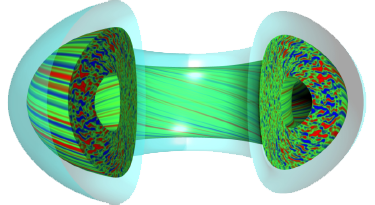Speaker
Description
In steady-state fusion devices like Wendelstein 7-X (W7-X), the active control of heat loads is mandatory to attain long-plasma operation. An intelligent feedback control system that mitigates the risk of overheating is required to avoid a premature plasma termination by the safety system. To keep the plasma within the safe operational limits of the plasma facing components, the feedback control system must be informed of the ongoing thermal events and their evolution in time. Then it can take effectives countermeasures to prevent the thermal events from reaching a critical point. These countermeasures may include reducing the heating power, changing the strike-line position or inducing detachment. With reaction times of the order of a hundred milliseconds, a fully automated real-time image analysis algorithm is required.
In this work, we present a spatio-temporal algorithm to detect, classify and track the thermal events observed by the thermography diagnostic on the plasma facing components of W7-X. The system detects and distinguishes between strike-lines and isolated hot spots as well as leading edges. The segmentation of the strike-line is specially challenging at W7-X. As a 3-dimensional helically-shaped stellarator equipped with 10 island divertors, the strike-lines have a complex heat load distribution with a high-dynamic range. The use of morphological tools and, in particular, the use of the Max-tree transform allow us to segment the thermal events in a hierarchical way preserving the inclusion relationship between different events, like hot spots and leading edges embedded in the strike-line structure. The thermal events are segmented for each frame and tracked over time in order to forecast their temporal evolution and to evaluate their risk. To this end, a spatio-temporal graph is built and spatio-temporal connected components are used to track the thermal events across the sequence frames. The spatio-temporal components in the graph are used to label the events in the sequence preserving temporal coherence and minimizing discontinuities, solving splits and merges. Spatio-temporal descriptors are then generated for each event to assess their risk.
The algorithm was tested offline on the infrared data acquired during the last operation phase OP1.2 and the results are presented here. Further work will follow to accelerate the code with GPUs to reach real-time processing and be ready to protect the water-cooled plasma facing components in the forthcoming operation phase OP2.
| Country or International Organisation | Germany |
|---|---|
| Affiliation | Max-Planck-Institut für Plasmaphysik |

